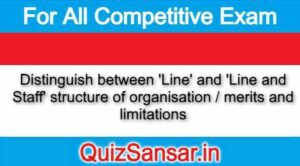
Distinguish between ‘Line’ and ‘Line and Staff’ structure of organisation / merits and limitations
Line (or scalar, or vertical, or military) Organisation
This refers to an organisational structure in which only one form of authority (i.e. line authority) exists. Line authority refers to the direct authority of an manager over his subordinates. It represents a direct vertical relationship, through which activity flows. The line of authority flows from top to bottom throughout the organisation. The quantum of authority is highest at the top and reduces at each successive level down the organisational scale. The line of authority also provides the formal channel of communication and accountability in the organisation. This type of organisation resembles a military administration.
Advantages (or Merits) of Line Organisation
Line organisation offers the following unique advantages:
1. Easy to Establish: It is simple to establish and can be easily understood by the employees. Every employee in the organisation knows his assigned tasks and to whom he is accountable.
2. Unity of Command: Every employee is a countable to one boss (superior) in the department. It facilitates unity of control, which is possible because of unified control. It is in accordance with the principle of scalar chain.
3. Quick Decisions: The unification of authority and responsibility ensures prompt decision taking. Here, a departmental head takes various decisions by himself without wasting time in deciding and referring things.
4. Direct Communication: There is a direct link between the superior and his subordinates. As a result, the grievances, suggestions, etc., of subordinates reach the top management in a short span of time.
5. Effective Co-ordination: It helps to achieve effective co-ordination The departmental manager is all-in-all about decision making. He can properly co-ordinate the activities of his subordinates and can direct the activities of his juniors.
6. Effective Control: The superior can exercise effective control over his subordinates as the number of subordinates is limited in the organisation. Moreover, there is a direct link between superiors and subordinates which facilitates a constant watch over the activities of subordinates.
7. Fixed Responsibility: it helps in fixing the authority and responsibility of each employee in the organisation. Everyone knows as to whom he is responsible and who is responsible to him. As a result, nobody can avoid responsibility.
8. High Adaptability: Adjustments and changes can be easily made in this type of organisation. It can easily adjust itself to suit changing conditions. The departmental manager can make changes if a new situation warrants, without wasting time.
Disadvantages (or Demerits) of Line Organisation
Line organisation suffers from the following limitations:
1. Lack of Specialisation: The departmental managers cannot be experts in every line of business. The quality of decisions may suffer when departmental managers take decisions with regard to every aspect of the department.
2. Overloading of Work: The departmental managers are too overloaded with their work. As a result, they may not be able to direct the efforts of their subordinates properly. The manager may not be able to perform his assigned task as he is overloaded with responsibilities.
3. Lack of Initiative: Here, the final decision is taken by the top management. Departmental managers have little power as the ultimate authority lies in the hands of the top management. This adversely affects their initiative to motivate their subordinates.
4. Scope for Favouritism: There is great scope for nepotism and favouritism in this type of organisation. Departmental managers judge the performance of subordinates according to their own norms and yardsticks. As a result, an inefficient employee (or yesman) may get a higher and better post.
5. Poor attention to Subordiantes : Subordinates put forward their grievances and suggestions to their superiors. The superior pays less attention to the suggestions sent by the lower ranks. As a result, subordinates start keeping a distance from their superiors.
6. Lack of Operational Uniformity: All departmental heads try to run their departments in their own way and according to their suitability. As a result, there may be a lack of operational uniformity among various departments.
7. High Concentration of Authority: Here, all decision-making of a department is entrusted to a single person (i.e. departmental manager). The success of the department depends upon the ability of the departmental manager. An error of judgement on his part may be fatal to the department.
Line and Staff Organisation Structure
Line organisation believes in too much centralisation of authority and control, whereas, functional (or staff) organisation believes in too much decentralisation of authority and flexibility. As a result, line organisation is autocratic and functional organisation has a slack control. Line organisation insists too much on unity of command, while functional organisation emphasizes too much on the decentralisation of control. Both line and functional organisations suffer from some limitations. In order to strike a happy balance between the two, a new type of organisation has been developed i.e. line and staff organisation.
In line and staff organisation, the structure is basically that of the line organisation, but staff officers (i.e. functional experts) are provided to advise the line authorities in the performance of their duties. Staff (or functional, officers render advisory aid to the line officers (i.e. departmental heads) but they have no power to enforce it. The power of enforcement remains with the line officers. Therefore, staff (functional) positions do not possess any authority as these positions are purely advisory in nature. Staff officers have power to recommend but not to enforce. On the contrary, a line officer is vested with excutive authority.
Advantages (or Merits) of Line and Staff Organisation The merits of line and staff organisation are stated below:
1. Improved flexibility : It is more flexible as compared to the line organisation. The degree of flexibility improves by the addition of staff officers to line officers. It enhances the scope for growth and expansion by providing the services of specialised staff to enable line executives to scope with challenging tasks.
2. Better discipline : The existence of a direct chain of command promotes discipline and makes control effective. The staff officers do not interfere with the executive work of the line officers. This creates better understanding and discipline among employees.
3. Planned specialisation: The staff specialists provide timely guidance to line executives on various problems. Staff officers concentrate on planning functions, whereas line officers concentrate on executive functions. This brings about expert ledge for the benefit of the organisation.
4. Prompt decisions : Staff specialists assist the line executives in taking prompt decisions by providing them with relevant information and proper advice. As a result, the line executives can easily and quickly take better and more sound decisions.
5. Reduced burden on line officers: The burden of line officers is reduced by the appointment of staff specialists. As a result, line officers can devote much time for future planning. Technical problems are undertaken by the staff officers and administrative matters are undertaken by the line executives.
6. Better staff Selection and development : Separation of planning function from ‘execution function’ facilitates staff selection and training. The creation of more posts enhances the promotional opportunities to able employees to prove their worth. It provides a scope for career advancement to able and dedicated employees.
7. Promoting effectiveness of executives: The strength and efficiency of line officers is bound to increase as their activities are supported by specialised staff officers. This promotes the effectiveness of the line executives.
8. Developing creativity and innovativeness: Research and development work is encouraged by the staff specialists belonging to various areas of operations. This promotes creativity of employees. As a result, innovativeness gets developed. This brings the benefits of reduced cost, improved quality and multiplied output.
Disadvantages (or Demerits) of Line and Staff Organisation
Line and staff organisation suffers from the following limitations :
1. Lack of co-ordination: There is lack of clear allocation of responsibility between line and staff officers. Moreover, overlapping activities lead to confusion and disorder. The line officer may reject the advice of the staff officer without assigning any reason for his action.
2. Conflict between line and staff personnel : The line officer may misunderstand the advice given by staff officers. Sometimes, line officers claim that staff specialists do not always provide correct advice. On the other hand, staff officers may feel ignored when line officers reject their advice without assigning any reason.
3. Lack of responsibility of staff officers: The staff officers cannot be held responsible if unfavourable results are obtained. As a result, they may not perform their duties well. Staff officers may be casual in their approach as the whole blame for non-performance line with line officers.
4. Loss of creativity of line officers: The line officers rely heavily on the staff specialists for their advice. This dampens the creativity and intitiative of the line officers. Often line officers refer everything to staff officers for their advice..
5. Expensive system: The need to employ two separate sets of personnel may prove to be expensive in terms of overhead charges. As a result, small and medium size organisations cannot afford such a system.
6. Complex organisational structure: The overall organisational structure becomes complicated and complex due to the introduction of staff relationships in the line structure. It suffers from the drawback of poor co ordination because of dual relationship in the organisation.
7. Weak position of staff officers: The staff specialists in an organisation seems to be very weak because they do not have any authority to assert on line managers. The staff officers may consider themselves unimportant and as a result, the quality of advice may be affected.
8. Danger of buck passing: Line and staff officers go on arguing for nothing without making any compromise for their work. It is really an uphill task to have integration to pull them together. That is why, one tries to blame another and avoids his responsibility.






